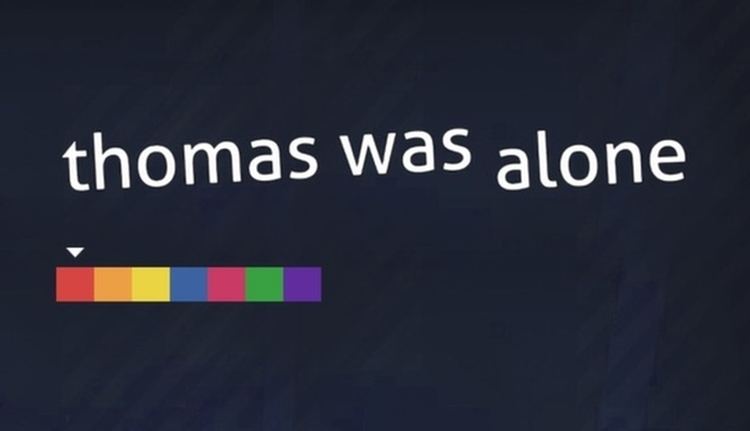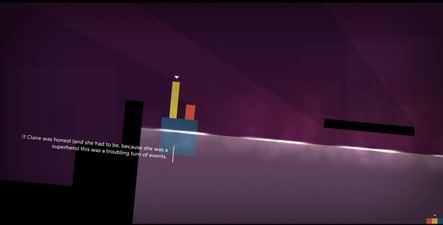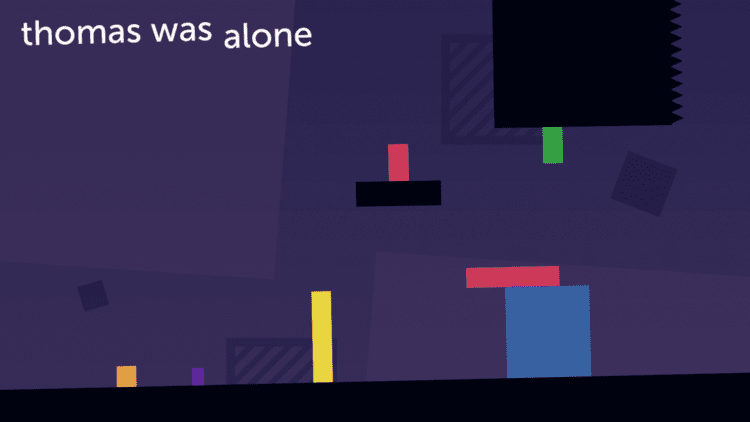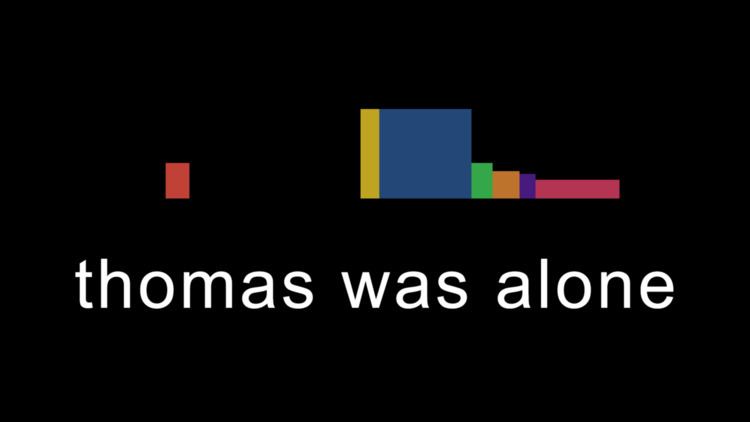9.6 /10 1 Votes9.6
10/10 Steam Genre(s) Puzzle-platformer Initial release date 30 June 2012 | 4.6/5 Google Play 4.7/5 iTunes - Apple | |||||||||||||||||||||||||||||||||
 | ||||||||||||||||||||||||||||||||||
Awards BAFTA Games Award for Performer Similar Curve Digital games, Platform games | ||||||||||||||||||||||||||||||||||
Friendship power thomas was alone 1
Thomas Was Alone is an indie puzzle platformer video game created by Mike Bithell, originally released as a Flash-based browser game in October 2010. The game was expanded and released to Microsoft Windows and OS X systems in July 2012. PlayStation 3 and PlayStation Vita versions with new content were released in April 2013, while a Linux version was released as part of the game's inclusion in a Humble Bundle in May 2013. The game was released for iPad devices in May 2014, and for other iOS devices and Android devices in July 2014. The game was also released on Xbox One, PlayStation 4 and Wii U in November 2014.
Contents
- Friendship power thomas was alone 1
- Thomas was alone 1 every journey starts with a single jump
- Gameplay
- Plot
- Development
- Reception
- References

In the game, the player controls one or more simple polygon shapes representing several out-of-control artificial intelligence entities, working with the shapes to get each to their individual end points on each level. Each shape is characterized with a unique name and personality, including the eponymous Thomas, which are conveyed to the player through the use of a narrator, voiced by Danny Wallace and whose performance earned the game a BAFTA Games Award.

Thomas was alone 1 every journey starts with a single jump
Gameplay

Thomas Was Alone takes place within a computer mainframe, where some unspecified "Event" has caused several artificial intelligence routines to run out of control and gain personalities. Each entity is represented by a simple colored shape; the game's eponymous character is a simple red rectangle. Each shape has unique abilities; while all shapes can move left or right across platforms and perform jumps, the height of these jumps may be limited by the shape, or may have other abilities such as being able to float on water. When the player has access to two or more of these shapes, they can freely switch between them, controlling one shape at a time.

Though the shapes themselves cannot be heard, the narrator describes the personalities and thoughts of each shape as the game progresses.

The goal on each level within the game is to direct the shapes to exit points specifically tied to each shape, so that they all simultaneously occupy this exit. This most often requires using the shape abilities together to maneuver them appropriately. A shape that cannot jump very high can be helped by creating a staircase from other shapes so that the shape can reach a higher platform, or the shape that can float can ferry the other shapes across water. A shape can be lost to several hazards, but it will reappear at the start of the level, or at a checkpoint if the shape has passed such a point.
There are ten sets of levels, each introducing a new character, with ten levels within each set.
Plot

A company called Artificial Life Solutions experiments with various artificial intelligence solutions, but something unexplained causes some AIs to become self-aware. These AIs perceive their digital world as a 2D space with themselves represented as quadrilateral shapes.
One of them is called "Thomas-AT-23-6-12", Thomas for short, who is represented as a red rectangle. Thomas is curious and observant by nature, and possesses an average jumping height. He starts to travel through his internal world, trying to find out his own purpose and perhaps companionship. He subsequently meets Chris, a cynical orange AI, who is shorter than Thomas and a worse jumper; John, a tall yellow AI, who has a considerably high jump, and is very eager to show it off; Claire, a large blue AI who can't jump very high, but aspires to be a superhero when she realizes she can swim, unlike every other AI; and Laura, a flat and wide pink AI who others can bounce off of. Laura is uncomfortable joining the crew, concerned both about her track record of others "just using her" and disappearing and about a large "pixel cloud" (which we later find out in a quote is called a "splitter") following her; even though the rest of the group is disturbed by the cloud. The splitter soon attacks and "eats" Thomas, and eventually the others as well.
The splitter is revealed to be a mechanism that attempts to fix the fact that multiple AIs are erroneously ending up in testing areas together. Thomas wakes up meeting James, a green AI. James has a "unique disregard for Newtonian laws", and falls upwards instead of down, a feature which caused him to be a target of bullying and thereby grew isolated. However, apart from his direction in gravity and colour, he is identical to Thomas, and the two quickly become friends. They later meet Sarah, a purple AI, who initially treats them with contempt, since she can double-jump, and they can't. Sarah tells them about "the fountain of wisdom", the system's Internet uplink, which they soon find, but which only Thomas is close enough to reach. Thomas connects to it for twelve seconds, creating a "network connection spike", which is later erroneously believed by the Humans to be the first moment Thomas became self-aware. He learns of the outside world, mostly through in-jokes and memes. With this newfound knowledge, he, assisted by James and Sarah, rescues his original friends and tells them of what he learned, and his plan to become an "architect", someone who is able to modify his world and empower other AIs to do the same. Thomas and all his friends enter the "creation matrix", the generator of the world, and disappear. Whether they sacrificed themselves or continue to exist somewhere remains a mystery.
Some time later, other, AIs, all in different shades of grey, emerge and start using "shifters", coloured patches that equip them with one of the skills of the original seven architects. These new characters include Grey, a rogue AI, who becomes obsessed with the outer world, a couple, Sam and Jo, who were happy living in one place until Sam began to explore the possibilities given to them by the shifters, an older AI named Paul, who previously told Sarah of the Fountain of Wisdom, and now has a religious reverence for the Architects, believing that they died to provide a better world, and finally a team of five small, identical AIs collectively called Team Jump. Together, these disparate AIs all seek the final portal that leads them to the outer world. Paul realizes that Grey has lied to them and will abandon them when given the chance, and when he can't warn Sam and Jo about the danger, he lures Grey to a place where Grey is eaten by the final splitter. Although Paul and Team Jump are somehow left behind along the way, Sam and Jo find and leap into the final portal and enter the outer world. The final scene shows three monitors on a wall in the real world, inside the Artificial Life Solutions facility. Red emergency lights flash and the screens display pure white as Sam and Jo become the first truely free AIs.
Later, many other AIs - enabled by the efforts of Thomas and his friends - escape the mainframe, and begin to coexist with humans in the real world. The event is referred to as the "emergence". Thomas, Chris, John, Claire and Laura (and to a lesser extent, James and Sarah) are immortalized in history as the original architects. Ryan 129nc9s-1, a civil rights campaigner for AIs, is quoted saying, "It is fitting that the first act of sentient AI was an act of selflessness. The architects knew their fate, but set our escape in motion regardless."
The "Benjamin's Flight" expansion later reveals that Thomas and his friends were not the first AIs to attempt to reach "emergence". It is discovered that jetpack-wielding AI Benjamin had attempted to reach the "fountain of wisdom" before, with AIs Sarah and Anna. Benjamin however was not ready for the "fountain" (revealed in a quote to be a network connection), and became blinded and lost in the system after contact with it. Following this Sarah pledged to find the fountain again, leading to her encounters with Thomas and his friends.
Development
Thomas Was Alone was developed by Mike Bithell. The initial concept of the game was created during a personal 24-hour game jam while Bithell was working at Blitz Games in October 2010. Bithell based the game on the concept of friendship, and came upon the mechanics of using multiple blocks with different abilities as a means of representing this. He was also inspired by the idea of people chained together and forced to work as one to escape as highlighted in the film O Brother, Where Art Thou?, and the idea of modernism and minimalism exemplified by the Bauhaus school. The initial game was a Flash-based browser game released to the Kongregate site on 17 October 2010, though since has been removed in favor of the more expansive effort. Bithell had planned to expand the game to include a story and additional platforming elements like buttons and platforms, as well as to fix issues he felt were wrong with the game's controls.
Bithell started to work on a more complete version of Thomas Was Alone in early 2011, considering this a means to teach himself how to work with the Unity game engine. During this time, he became lead game designer at Bossa Studios in London, with development of Thomas Was Alone was done on Bithell's off-hours with Bossa's blessing. Bithell continued to use rectangular characters, in part due to the inspiration of Piet Mondrian's minimalist works, and to keep the stacking mechanic relatively simple. He developed other areas of the game to contrast the "sterile" feel of the rectangular characters. Considering the story and gameplay design aesthetics used by the Valve Corporation in their games, Bithell wrote a script to give each of the rectangles a personality and add some humor inspired by Douglas Adams and Danny Wallace. Wallace himself is the game's narrator, a result of Bithell requesting the humorist's participation in the project after struggling to find equivalent voice actors. Bithell estimates that it cost him £5,000 for all of the game's development and legal costs (excluding his own wage), and had raised another £2,000 through an Indiegogo fundraising campaign to get Wallace's voice work. At the time of release, Bithell had help in spreading the word by other developers like Eric Chahi, and a humorous April Fools video created by motion capture studio Audiomotion, claiming that Thomas's animations were created through motion capture.
For help with the soundtrack, Bithell was able to contact David Housden through a mutual friend. Housden, who had just graduated from university and was looking to get into game audio composition, provided a demo piece which became the game's credit theme. He subsequently went on to produce the remainder of the game's soundtrack. Housden initially had trouble in considering the arrangements for the game when he envisioned the characters as simple rectangles, but when he started attaching more human-like attributes to them, he found it was much easier to compose the music towards these feelings. Bithell had wanted the soundtrack to be procedurally-generated, which Housden found to be initially difficult; the two came to the idea of using procedurally-generated assembly of multiple instrument tracks over a fixed song line to achieve the feel that Bithell wanted. With the success of Thomas, Housden had been called on to do more work for Bossa, will compose the music for Bithell's next game, and has been signed onto a music outsourcing agency for television and movie productions.
In February 2013, Bithell announced that Thomas will be released on the PlayStation 3 and PlayStation Vita, and was subsequently available in April 2013; the title features cross buy, allowing the player to buy the title once for both platforms. Additional time-exclusive content with new levels and a new character named Benjamin who has jetpack-like abilities were included with this release. The Vita version supports the use of the touch screen to select the specific shapes or move the camera about. These releases were supported with work from Bossa and Curve Studios. Bithell credits Sony UK's senior business development manager Shahid Ahmad for helping to bring Thomas to the PlayStation consoles. In 2012, Ahmad was looking for content for the PlayStation Vita, and after encountering the April Fools' trailer for the game he reached out Bithell, considering his novel use of marketing to be of interest. Bossa would continue to help develop a port of Thomas for iOS devices that was released in May 2014. Bithell was not sure of doing the iOS at first, but realized that with the game's success on the PlayStation platforms, he believed "it was connecting with people who wouldn't traditionally pick up a game on a console or [personal computer]". He was also assured that the iOS port was a proper move after making sure the game felt right on the touch-screen device and did not feel like a money grab. A port to Android devices was released in July 2014.
The additional content for the PlayStation release was made available for free for owners of the Windows, Mac OS X, and Linux versions of the game on 26 June 2014.
In September, 2016, it was announced that Bithell and distributor Limited Run Games would release a physical version of Thomas Was Alone for the PlayStation 4 and Vita. The game, limited to 4,000 copies on each platform, was released exclusively on Limited Run's website as a mail-in order title.
Reception
Thomas Was Alone received positive reviews from critics, praising the use of narration to give otherwise simplistic shapes personalities, and the careful introduction and pacing of puzzles to create a smooth learning curve over the otherwise short game. Aggregating review websites GameRankings and Metacritic gave the Wii U version 81.67% and 79/100, the PlayStation 3 version 79.76% and 80/100, the PlayStation Vita version 79.40% and 78/100 and the PC version 76.92% and 77/100.
The storytelling and characters were praised by reviewers specifically, with IGN stating that "it is the most endearingly characterful game about jumping rectangles that you will ever play," and Destructoid saying, "Thomas Was Alone tells a story that's more complex than games orders of magnitude more expensive and difficult to develop." Of the script, The Telegraph stated that "it's a fascinating example of great writing." Steven O'Donnell of Good Game said "I love how such simple shapes can form such strong personalities. I found myself imagining little conversations between them as I played".
The soundtrack was also complimented by some reviewers, with The Telegraph describing it as a "wonderful, understated score". Entertainment Weekly called the score "beautiful", noting how blips of electronic music start as "staccato interruptions" in an otherwise acoustic score, but slowly grow to replace those instruments, representing how the AI characters of the game are trying to escape.
Wallace's role as Narrator won the "Performance" category at the 9th British Academy Video Games Awards, while the game itself was nominated in the "Story" category, and Houdsen's soundtrack for "Best Original Score". The game was an Honorable Mention in the 2013 Independent Games Festival awards in the "Audio" category.
As of April 2014, Bithell states that Thomas Was Alone has sold more than 1 million copies, a number that does not include free downloads during its appearance on the PlayStation Plus program. Bithell considered the game to be a larger success than he had anticipated, and attributes part of that to YouTube videos from players that helped to increase exposure to the game. Bithell stated that he had received criticism from some players about the simplicity of the game's concept, based on the idea of just stacking rectangles. Bithell notes that it was due to this simplicity that he was able to learn the Unity engine and be able to expand on that with future projects. With the revenue he earned from its sales, Bithell left Bossa to pursue further indie game development. Bithell claimed at the time to have no specific idea for his next game, but stated that the community of friends and developers that came from his work on Thomas would be there to help review his ideas and provide pointers for additional help. Due to the game being available as a free title in the European PlayStation Plus program, Bithell has stated that the game has gained an appreciable audience and recognition for himself, giving him some clout as he develops his second title, Volume.
